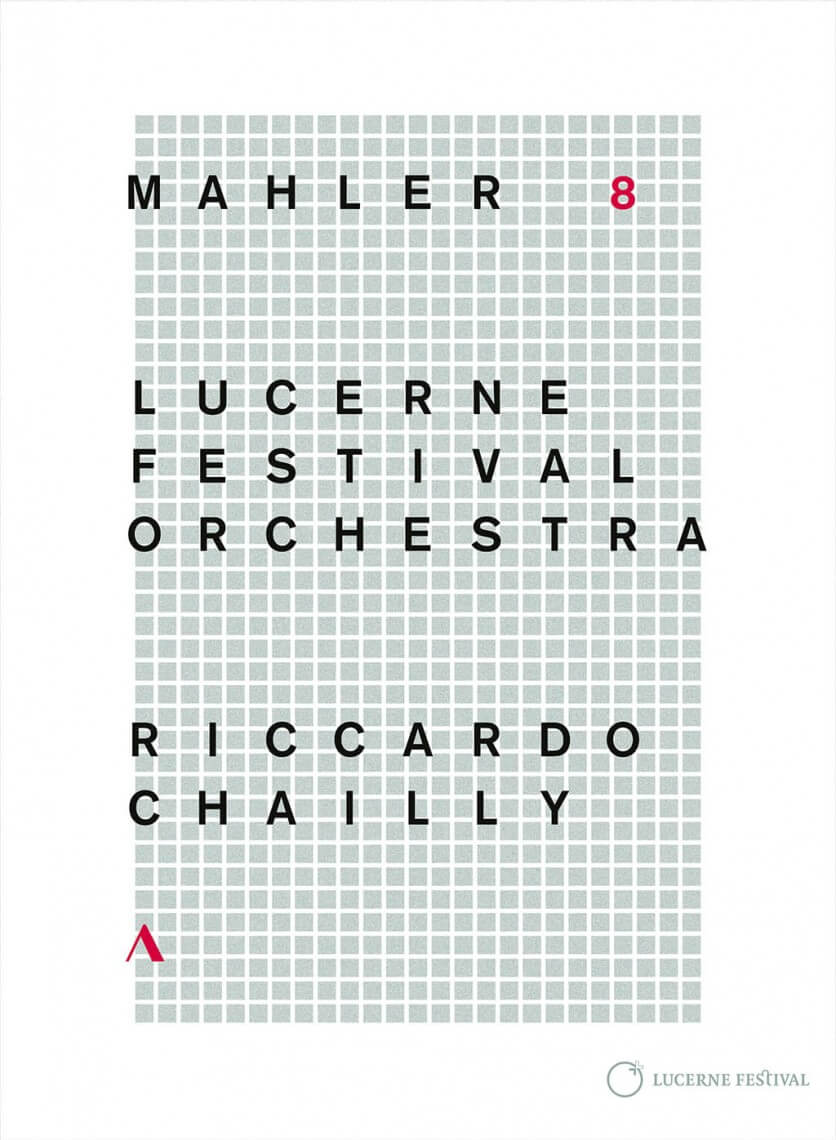
Mahler: Symphony No. 8 in E flat major. Ricarda Merbeth, Juliane Banse, Anna Lucia Richter, Sara Mingardo, Mihoko Fujimura, Andreas Schager, Peter Mattei, Samuel Youn. Bavarian Radio Chorus, Latvian Radio Choir, Orfeón Donostiarra, Tölzer Knabenchor. Lucerne Festival Orchestra/Riccardo Chailly. Recorded live at the 2016 Lucerne Festival. Accentus Music DVD ACC 20390. Total Time: 92mins
Claudio Abbado passed away January 20, 2014. Over the course of his career he headed La Scala, the Berlin Philharmonic and the London Symphony, but one of the crowning achievements of his later years was the re-creation of the Lucerne Festival Orchestra. Beginning in 2005 Abbado assembled an all-star orchestra to give several concerts at the prestigious Lucerne Festival. The orchestra included members of the Berlin Philharmonic, the Vienna Philharmonic, the Royal Concertgebouw Orchestra and many other leading European orchestras. Under Abbado the orchestra was widely acclaimed for the quality of its performances and many of them were released on DVD and compact discs. After Abbado’s death there was some doubt whether the orchestra would continue, but finally a decision was made to appoint Riccardo Chailly as his successor. Chailly had been Abbado’s assistant at La Scala decades earlier in the 1970s and had himself become their musical director. Among Abbado’s projects with the Lucerne Festival Orchestra was the performance of all the Mahler symphonies. He did not live to complete the project and appropriately for his first concert with the Lucerne Festival Orchestra, Chailly chose the one Mahler symphony Abbado never conducted at the festival.
Riccardo Chailly has been authoritative in Mahler for a very long time and to my knowledge is the only conductor to have made three recordings of the massive Symphony No. 8. His first version, part of a complete Mahler symphony cycle with the Royal Concertgebouw Orchestra, was made in 2001 (Decca 482702) and among its outstanding assets is the Canadian tenor Ben Heppner. Chailly did the piece again with the Leipzig Gewandhaus Orchestra in 2011 (Accentus Music Blu-ray 10222).
Any performance of the Mahler Eighth is an event given the huge forces required. It is known as the “Symphony of a Thousand,” although Mahler didn’t give it that name, and it requires eight vocal soloists, several adult choirs, a boy’s choir and an orchestra of well over a hundred players. Among the instruments needed are celesta, harmonium, mandolin, piano, two harps, organ, large bells, and an offstage brass group of seven players. On a DVD it is impressive to see all these performers arrayed on the stage of the Concert Hall of KKL Lucerne. Producer Paul Smaczny does a fine job being in the right place at the right time for us to see the eight horns at rehearsal number 80 with their bells in the air (“Schalltrichter auf”) in accordance with the composer’s instructions, the sheer size and weight of the bells, and magnificent entrance of the extra brass standing in the choir loft behind the orchestra at the end of the first and second movements.
While Mahler has created a glorious tumult of sound in this symphony, especially in the last fifteen minutes or so as he slowly ratchets up the tension and masterfully weaves together all the main musical ideas, I must confess that the Eighth is my least favorite Mahler symphony. The first movement is a setting of the medieval hymn Veni, Creator Spiritus (Come, Creator Spirit) and its full-throated exuberance is almost irresistible by virtue of its sheer power. But the second movement, lasting over an hour, is much more introspective—at least until the magnificent final section—and somewhat obscure in its setting of the closing scene from Goethe’s Faust. I find it difficult to fully engage with the flowery mysticism of the poetry setting out the journey of Faust’s soul to heaven, and his redemption through the power of a woman’s love; here, we have yet another version of the same theme originally worked over by Wagner in operas such as Die Fliegende Holländer, Lohengrin, and Tristan und Isolde. For me, Mahler’s treatment of the idea is overblown and long stretches of the symphony often lack really interesting musical innovation.
Chailly leads an efficient and committed performance although it seldom approaches the Olympian level so often achieved by Abbado with this orchestra and in this hall. Soloists are generally excellent with soprano Anna Lucia Richter as Mater gloriosa wonderfully pure of voice in the final bars. The choruses could hardly be better. The Bavarian Radio Chorus is always superb and the Orfeón Donostiarra from the Basque region of Spain is one of the greatest amateur choruses in the world.
For more RECORD KEEPING, see HERE.
#LUDWIGVAN



